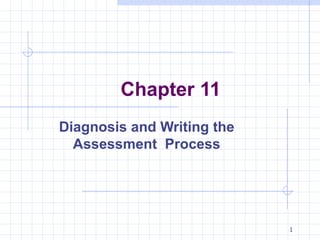Chapter 11
- 1. Chapter 11 Diagnosis and Writing the Assessment Process
- 2. The Importance of Diagnosis Read vignettes at beginning of chapter (pp. 245-246) Some reasons for its current importance: Changes in federal laws (e.g., IDEIA) Needed for 3 rd party payments To communicate with other clinicians Many diagnoses are likely biologically causedâthus definitive diagnosis is needed for proper treatment Helpful for case conceptualization and treatment planning
- 3. What is DSM-IV-TR? Diagnosis: Derived from the Greek words dia (apart) and gnosis (to perceive or to know) DSM-I developed in 1952 by Am. Psychiatric Association Today, five axes: Axis I: Clinical Disorders and Other Conditions That May Be a Focus of Clinical Attention Axis II: Personality Disorders and Mental Retardation Axis III: General Medical Conditions Axis IV: Psychosocial and Environmental Problems Axis V: Global Assessment of Functioning .
- 4. Axes I and II: The Mental Disorders Each mental disorder covered in DSM-IV-TR describes: the disorderâs main features subtypes and variations in client presentations the typical pattern, course, or progression of symptoms how to differentiate the disorder from other, similar ones
- 5. Cultural Issues and the Mental Disorders Some things not diagnosable: Client reactions to expected culturally appropriate reactions to life events (e.g., loss of loved one and depression) Phase of life developmental issues Culturally specific reactions that may seem unusual in âwesternâ culture Most problems not âdiagnosableâ and for those who have a âdiagnosis,â most live relatively ânormalâ lives
- 6. Cultural Issues and the Mental Disorders (Contâd) Throughout DSM-IV-TR acknowledgement is made of gender, cultural, and age differences DSM includes appendix of culture-specific client experiences not included elsewhere (E.g., Koro): A term, probably of Malaysian origin, that refers to an episode of sudden and intense anxiety that the penis (or in females, the vulva and nipples) will recede into the body and possibly cause death. . . . (APA, 2000, p. 900)
- 7. Axis I Disorders Clinical Disorders and Other Conditions That May Be a Focus of Clinical Attention All disorders except for those classified as personality disorders or as mental retardation (Axis II disorders) Considered treatable in some fashion and are often reimbursable
- 8. The Axis I Disorders Delirium, Dementia, Amnestic, and Other Cognitive Disorders Mental Disorders Due to a General Medical Condition SubstanceâRelated Disorders Schizophrenia and Other Psychotic Disorders: Mood Disorders Anxiety Disorders Somatoform Disorders Factitious Disorders Dissociative Disorders Sexual and Gender Identity Disorders Eating Disorders Sleep Disorders Impulse Control Disorders Not Elsewhere Classified Adjustment Disorders
- 9. Axis II Disorders: Personality Disorders and Mental Retardation Long-term disorders in which treatment almost always has little or no affect on changing presenting symptoms of the individual.
- 10. The Axis II Disorders Mental Retardation: Intellectual functioning below 2nd percentile and problems with adaptive skills Four categories: mild (IQ of 50-55 to 70) moderate (IQ of 35-40 to 50-55) severe (IQ of 20-25 to 35-40) profound (IQ below 20 or 25)
- 11. The Axis II Disorders (Contâd) Personality Disorders: Deeply ingrained, inflexible, and enduring patterns of relating that lead to distress and impairment. Cluster A: paranoid, schizoid, and schizotypal disorders. Characteristics: odd or eccentric. Cluster B: antisocial, borderline, histrionic, and narcissistic disorders. Characteristics: dramatic, emotional, overly sensitive, and erratic. Cluster C: avoidant, dependent, and obsessive- compulsive disorders. Characteristics: anxious and fearful traits.
- 12. The Axis I and Axis II Disorders Role Play Activities: Axis I: Exercise 11.1, p. 251 Axis II: Exercise 11.2, p. 252
- 13. Axis III: General Medical Conditions Medical conditions Either reported on Axis III alone, or reported on Axis III and Axes I or II also if it causes the disorder. Use ICD-9-CM code (abbreviated table in DSM-IV-TR Exercise 11.3, p. 253
- 14. Axis IV: Psychosocial and Environmental Problems Psychosocial or environmental problems that affect the diagnosis, treatment, and prognosis Either reported on Axis IV alone, or reported on Axis IV and Axes I or II also if it causes the disorder Exercise 11.4, p. 253
- 15. Axis V: Global Assessment of Functioning (GAF) Used to assess the overall functioning of the client. Based on clientâs psychological, social, and occupational. Can indicate current functioning, functioning of past 6 months, and so forth. Important for showing that progress is being made. See Table 11.1, p. 254 Exercise 11.5, p. 255
- 16. Making a Diagnosis DSM offers a decision tree to help in making a diagnosis Client can have more than one diagnosis Example: Axis I: 309.0, Adjustment Disorder with Depressed Mood Axis II: 301.82, Avoidant Personality Disorder Axis III: V71.09 No Diagnosis Axis IV: Divorce Axis V: GAF = 60 (current), 75 (highest in past year)
- 17. Final Thoughts on DSM-IV-TR Part of total assessment process With clinical interview, use of tests and informal assessment procedures, provides broad understanding of client helps in treatment planning The more âpieces of information,â the better your predictions about the client. Exercise, 11.6: Using the Five Axes (p. 256)
















